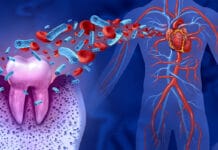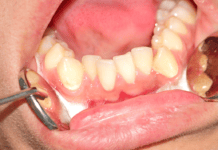Why is pain so variable with dental patients? How do some patients tolerate non-surgical periodontal therapy along root surfaces with zero anesthetic? They take it like a champ ─ no flinching, no facial gestures, no moaning, no fidgeting, and no “ouch.” After the dental appointment ends, they reflect, “It wasn’t as bad as I thought it would be.”
However, other dental patients flinch, move, sigh heavily, and say “ouch” while the dentist or dental hygienist simply holds instruments outside of the mouth. Pain is subjective and individualized, affecting everyone differently.
According to the International Association for the Study of Pain, pain is defined as “An unpleasant sensory and emotional experience associated with or resembling that associated with actual or potential tissue damage.”1
Pain is the body’s warning signal that something is wrong, and the cause needs to cease.
Pain Pathway
Pain is a broad term to define uncomfortable sensations in the body and originates from the nervous system. It is a symptom of an underlying condition. Pain comes from the nervous system ─ the brain and the spinal cord. This forms the central nervous system while the sensory and motor nerves make up the peripheral nervous system.
The brain and spinal cord are the core of the system, while the sensory and motor nerves access the rest of the body. The sensory nerve sends the messages back to the brain via the spinal cord. When an injury happens, the variety of sensory nerve fibers respond by producing chemical responses, which determine how sensations are interpreted. Within this response are pain receptors called nociceptors.
Nociceptive pain is physical pain from an injury. An injury can be somatic, affecting the bones, joints, or muscles, or visceral, affecting the internal organs. After an injury, nociceptors’ own sensory endings on nerves are triggered to excite within the body to send a warning signal of potential or actual harm, which happens quickly within the body. It’s an early self-protective system ─ to feel pain to warn and avoid harm. An example is touching something hot.
When pain reaches the spinal cord and its bundles of nerves, pain transmits messages to and from the brain. Pain works through reflexes. The dorsal horn in the spinal cord is the information center to direct impulses to the brain and back down through the spinal cord to the injured site. After the initial pain has started, the brain distinguishes what happened and passes it on to the thalamus to interpret it to the cortex. This is when the brain becomes familiar with the type of sensation such as sharp, dull, throbbing, achy, and more.
This distinguished pain is also sent to the limbic system, the emotional center of the brain. This wonderful system determines our emotional reactions, such as crying. The emotional response could generate other body responses as sweating, heart rate increase, nausea, or the feeling of passing out.2
Pain is interpreted from past pain experiences, mood, and mental health. If you are happy and jubilant, the pain may feel lessened. If you are depressed or grieving, the pain may feel more intense.
Once the injury has healed, the nociceptors determine health and quit sending signals to prevent chronic pain. If nociceptors continue to fire either by the injury that continuously causes damage or for no known reason after the healing process, the response shifts into chronic pain.
Nociceptive inflammatory pain is applied after the injury and is the inflammatory process of repairing and healing. This is when the white blood cells, neutrophils, macrophages, and monocytes are released.
An example is a sprained ankle. When the initial sprain happens, there’s usually an instant signal of pain, resulting in swelling, bruising, redness, and warmth to protect the site of injury. Following the injury, repairing and healing takes place through white blood cells helping clean up dead cells and foreign matter at the site of injury to clear away the inflammation.
Nociceptive noninflammatory/nonneuropathic pain involves abnormal nerve signaling when there isn’t any injury. An example is fibromyalgia. This condition is pain throughout the body. It may shift around and can affect multiple areas of the body. It is hard to diagnose as it occurs without any specific trauma. With significant pain and no specific injury, it can cause abnormal pain signaling.
Neuropathic pain is associated with injury or disease of nerve tissue. It is an abnormal nerve function with sensations along the affected nerve that may cause tingling or numbness. Feelings of shooting, stabbing, burning, electric shock, and prickling with hypersensitivity to touch, hot and cold, movement, and pressure can be felt with neuropathic pain. Examples are diabetic neuropathy and shingles.3
Pain Levels
Pain levels are described in many aspects in which patients vocalize. In dental hygiene school, we were taught never to use the word pain; discomfort was the more appropriate word.
Definitions of pain include:
- Discomfort: slight pain
- Pain: physical suffering or discomfort caused by illness or injury
- Aching: sore; throbbing with pain
- Agonizing: causing physical or mental pain
- Uncomfortable: causing or feeling slight pain or physical discomfort
- Sensitive: quick to detect or respond to slight changes, signals, or influences
- Dying (as some patients describe): on the point of death
- Hurt: cause physical pain or injury to
- Sore: painful or aching
- Tender: sensitive to pain
- Unbearable: not able to be endured or tolerated
- Pressure: continuous physical force exerted on or against an object by something in contact with it
- Excruciating: extremely painful, intense suffering, unbearably distressing, torturous
When pain is described, certain words are commonly used prior to describing the pain, such as the degree of it.
- Slight is a small degree, inconsiderable.
- Moderate is average in amount, intensity, quality, or degree.
- Severe is very great of something bad or undesirable or intense.
Tolerance of Pain
Why do some people tolerate pain well while any sense of pain debilitates others? This toleration depends on pain threshold and pain tolerance.
Pain threshold is when pain is perceived at the lowest intensity of a stimulus. It’s the duration of time before the individual can no longer tolerate the stimulus. The pain threshold levels vary from person to person, and the more someone experiences pain, the more they develop a higher threshold. There is a safety limit in the body to where the body can only tolerate so much.4
Pain tolerance is when the highest level of pain can be endured. The perception of pain is paired. The first is biological, with the initial injury to activate the pain receptors. The second is the brain’s perception of pain and how much attention it gives to the pain. Men tend to have a higher tolerance.5,6 When studies where men and women are tested with pain, women tend to express pain before men, suggesting men can tolerate intense pain more and longer.7
High pain tolerance can be dangerous. When people do not feel pain, the body’s natural warning signals can cause serious trauma. As dental professionals, we come across patients who are not in pain, and we wonder why after evaluating the horrible condition of a tooth and are shocked how the patient doesn’t even feel a twinge. While these patients are heaven to work on, it could be dangerous for them as an injury could happen, and the patient may not feel it for them to respond to stop the action.
Acute pain comes on suddenly, mainly from a disease, injury, or inflammation. It subsides after an illness or the injury has healed. If it doesn’t go away, it turns into chronic pain.
Chronic pain is ongoing or recurrent and continues after the illness or injury has healed with a time frame of more than three months. It may be continuous and lead to duration and intensity to negatively disturb the quality of life. Pain is not meant to last for a long time and, when it does, it can increase prolonged mental, emotional, and behavioral factors.3 Chronic pain has an effect on the brain and can cause changes within the brain to cause hypersensitization. Emotions can increase or downplay the pain.6
Anyone who has experienced chronic pain knows the insanity it can cause. Day in and day out can make the most rational person have intense thoughts just for a little bit of relief. I have come across two dental patients who have been in so much pain they pulled out their own teeth during my career.
Medical Conditions Associated with Chronic Pain
Arthritis is inflammation of joints that can promote severe pain, mood, and anxiety disorders.
Fibromyalgia is a chronic multisymptomatic condition where the central nervous system computes pain signals differently, affecting the muscles and bones.
Multiple sclerosis affects the nerves and affects signaling between the brain and body.
Back/neck pain is a range of pain affecting the nerves, muscles, tendons, or ligaments and causes depression and mental health.
Chronic migraines are severe pain in the head, such as throbbing or pulsing sensation, and increases mental health issues and depression.7
Continuum of pain begins with an acute stage as a temporal process and continues into a variable duration of a chronic stage. Pain will last more than half a day.3
High impact chronic pain is when pain is debilitating enough to alter daily functions of work, social, and self-care for longer than six months. This category of pain is more severe with people who have challenges providing self-care, mental health, and cognitive impairments.3
Variations of Pain
Flare-up pain is a temporary increase in pain within a stable or controlled level of pain. It may be caused by changes in physical actions or activity levels such as standing up or rolling over. Emotional plights of stress, anxiety, anger, and fear may cause flare-ups.3
Referred pain is the classic description of pain from a patient where it might be “the top or bottom,” “the very back or towards the front,” where they use their finger to feel the sensation, and the finger is traveling around touching all the teeth on one side. Referred pain is felt in a part of the body other than the actual source.
With the teeth being adjacent to one another and one nerve supplying multiple teeth, it can be challenging to know exactly which tooth is aching. When there is pain, the nervous system transports the signal to the brain. In return, the brain will send a signal back to a surrounding area or a different area altogether, causing referred pain and confusion in locating the pain.
Hyperalgesia is an abnormally increased sensitivity to pain caused by damage to the nociceptors or peripheral nerves. Primary hyperalgesia is pain sensitivity directly related to damaged tissues. Secondary hyperalgesia is pain sensitivity in the surrounding undamaged tissues.9
Hypoalgesia is a decreased sensitivity to painful stimuli. This happens when there is a disruption with a painful stimulus along the pain’s pathway of process and recognition.10
Allodynia is an increased pain felt from a stimulus such as touch, pressure, cold, heat, and pinprick, which usually wouldn’t provoke pain.11
Certain conditions can increase the sense of pain:
- Stress: affects the modulation of pain, and the more stress involved results in a lower pain tolerance
- Lack of sleep: diminishes pain tolerance
- Depression: increases the feeling of pain
- Genetics: the gene that blocks BH4, a chemical in the body that increases sensitivity to pain. People who naturally can block BH4 are less sensitive to pain.
- Gender: men tend to tolerate pain more than women
- Exercise: people who exercise can withstand more pain the physically inactive
- Redheads: are more sensitive to pain as they have a certain gene called melanocortin-1 receptor, which provides the red hair color. This gene influences pain receptors with sensitivity.
- Age: children experience more pain than adults
- Depression and anxiety: will experience more feelings of pain.4
Vocal Response to Pain
The word “ow” or “ouch” is often expressed involuntarily to sudden sensations of pain. According to the Journal of Pain, saying “ow” helps modulate the pain. Swearing also helps with dealing with pain since hearing one’s own voice could be an analgesic.
Other reduced pain behaviors are deep breathing and closing the eyes. Listening to music is shown to reduce somatosensory discrimination and pain perception.12
Types of Pain Conditions
Nerve Pain
Neuropathic pain is caused by damage or disease and affects the nervous system. This pain comes from peripheral, central, or both systems. Peripheral components are the nerves and ganglia outside the spinal cord and brain and have feelings of burning, tingling, electrical, stabbing, and pins and needles as when hitting the funny bone.13
Nerve pain is like no other. The nerve is affected in the tooth from dentinal or pulpal sensitivity through recession, wear, decay, broken or infection of a tooth. When an external stimulus such as heat, cold, acidity, or sweets reaches the nerve endings in the dentin, it causes a strong sensation through what seems not only the tooth but feels like it zaps the brain.
Psychogenic Pain
Psychogenic pain is a pain disorder associated with psychological factors. Physical pain can be caused by mental, emotional, and behavioral factors related to beliefs, fears, grief, and anxiety. This can cause prolong or increased pain. Chronic psychogenic pain may act as a distraction to underlying or unexpressed emotions.14
Pain Disorder
Pain disorder is chronic pain experienced in one or more areas of the body caused by psychological stress. This type can be debilitating for daily functioning and can last for a few days or years. It usually occurs after a traumatic event as an accident, an illness, or drug addiction.
Pain and Anxiety Correlation
In my experience, dental patients with anxiety tend to be more fidgety, vocal with any pain, and express facial gestures. Anxiety actually can increase pain by causing chemical changes in the brain to lower the threshold and worsen the sensation of pain. Anxiety causes tension in the nervous system, which leads to constriction of blood vessels and, over time, can make muscle spasms and tension worsen.
Pain and Stress
Pain is a survival signal for the brain to prepare for fight or flight, releasing physical and chemical changes. Some of the changes increase heart rate and blood flow to the muscles.
Pain and Fear
Fear keeps many dental patients from not only having dental work but from missing appointments for years. Much of the time, the fear is experiencing pain. Emotional, cognitive, behavioral, and psychophysiological factors are all involved in this complex notion. Just the perception of possibly experiencing pain is a huge roadblock to completing an appointment.
Pain is such an individual feeling that it’s hard to really determine how much pain a patient is really experiencing. It can range from feeling barely any pressure as painful to actually having it shoot throughout the body kind of pain.
In dentistry, physical and mental pain is variable as much of it is related to anxiety and fear. Within dentistry, when the patient uses the word “pain,” there’s more of an emergency for a resolution. In many instances, pain is the deciding factor for patient approval of treatment.
Trying to be more understanding of a patient’s pain will make the dental appointment more comfortable for them.
Need CE? Click Here to Check Out the Self-Study CE Courses from Today’s RDH!
Listen to the Today’s RDH Dental Hygiene Podcast Below:
References
- IASP Announces Revised Definition of Pain. (2020, 16 July). International Association for the Study of Pain. Retrieved from https://www.iasp-pain.org/PublicationsNews/NewsDetail.aspx?ItemNumber=10475
- Tanvi, K., Valluvan, R. Cognition and Pain: A Review. (2021, May 21). Frontiers in Psychology. Retrieved from https://www.frontiersin.org/articles/10.3389/fpsyg.2021.673962/full
- Chronic Pain Management. (2021). American Chronic Pain Association. Retrieved from https://www.theacpa.org/resources/acpa-resource-guide/
- Pain Tolerance and Pain Threshold (2017, March 23). Novus Spine & Pain Center. Retrieved from https://novusspinecenter.com/blog/pain/pain-tolerance-pain-threshold
- Johnson, J. (2020, July 12). High Pain Tolerance: Causes, Influences, and How to Affect It. Medical News Today. Retrieved from https://www.medicalnewstoday.com/articles/high-pain-tolerance
- Woznicki, K. (2014, March 31). What’s Your Pain Tolerance? WebMD. Retrieved from https://www.webmd.com/pain-management/features/whats-your-pain-tolerance#1
- Calandra, B. (2005, January 30). Gender: Some Painstaking Differences. Retrieved from https://www.medicinenet.com/script/main/art.asp?articlekey=51160
- Chronic Pain and Mental Health. (n.d.). Mental Health America. Retrieved from https://www.mhanational.org/chronic-pain-and-mental-health
- Nall, R. (2017, August 06). Hyperalgesia: What You Need to Know. Medical News Today. Retrieved from https://www.medicalnewstoday.com/articles/318791
- (n.d.). Psychology Wiki. Retrieved from https://psychology.wikia.org/wiki/Hypoalgesia
- (2021, May 05) Cleveland Clinic. Retrieved from https://my.clevelandclinic.org/health/symptoms/21570-allodynia
- Swee, G., Schirmer, A. On the Importance of Being Vocal: Saying “Ow” Improves Pain Tolerance. Journal of Pain. 2015; 16(4): 326-334. Retrieved from https://www.jpain.org/article/S1526-5900(15)00032-2/fulltext
- Santos-Longhurst, A. (2018, November 29) Types of Pain: How to Recognize and Talk About Them. Retrieved from https://www.healthline.com/health/types-of-pain
- Pain: Psychogenic Pain. (n.d.). Cleveland Clinic. Retrieved from https://my.clevelandclinic.org/health/diseases/12056-pain-psychogenic-pain












